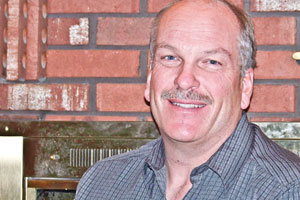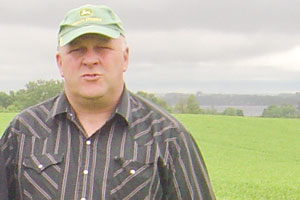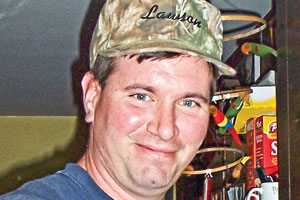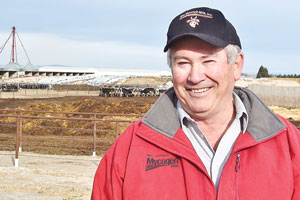We also asked them to share a piece of advice that might help other producers be more successful with their silage crop.
As you look back on your year, what would your answers to these questions be? Will you be doing anything different next season? Do you have any good tips or lessons to share? E-mail your answers to editor@progressiveforage.com and we’ll post them on our website.
And a very special thank you to Jeff, Rodney, Scott, Chris, Keith and Ray, as well as the seed companies that put us in touch with these producers, for their participation in the column this year.
 Jeff Handschke
Jeff Handschke
Sugar Creek Dairy • New London, Wisconsin
We are still waiting for forage quality results from our twin row plots. We can see from the yield monitor in the chopper that our tons per acre has increased by using twin rows, but all is for naught if the quality is not there.
As of right now I may increase twin row acres from 100 acres this year to 400 acres next year if we maintain or increase silage quality.
My advice is to keep looking for ways to push the envelope. As costs continue to increase we need to keep trying to squeeze every dollar out of every acre of production. We always have about 50 to 100 acres here that we are trying something different with to become more productive.
 Rodney Elliott
Rodney Elliott
Drumgoon Dairy • Lake Norden, South Dakota
We had essentially no rain this summer, and some spots in the fields dried out very quickly.
We learned that we have to be more aware of this and not plant the high-forage silage varieties in those dry areas, as some of the more conventional corn hung in there a bit longer.
We will be looking at our feed rations to see if we need to make changes based on this year’s high prices.
We probably won’t ever have all the land we need to grow enough corn for all our silage, so we always need to be looking for reliable alternatives.
It’s important to always make the most of the product you do produce. Pay attention to spills, overloading in the field and product lost down the road.
Tighten up your pile packing and management. Make sure that the dollars spent end up in the cows.
 Scott Reiland
Scott Reiland
Reiland Farms • LeRoy, Minnesota
This year started off with wet weather, and we ended up planting a few weeks later than normal. We also had some very high straight-line winds come through this area, which caused a bit of lodging.
But all in all we were very lucky because we ended up having a hot summer. The corn did an amazing job of catching up, so we harvested earlier than I anticipated.
We aren’t going to change varieties unless something new is introduced that would fit our needs. We’re very happy with the way our BMR hybrids performed.
My advice to other producers about BMR corn silage is to grow it on your best ground, practice good fertility and don’t push the population.
All in all it was a good year, and we don’t anticipate doing anything differently next year — but guess we’ll just have to wait and see.
 Keith Dawydko
Keith Dawydko
Anchor Farms, Inc • Clarence, New York
I learned that the chopper was a better place to inoculate the corn silage. I think we get a lot better coverage on the crop being chopped.
I am always the one who is doing the chopping. The person hauling and unloading wagons is most of the time hired labor, so there can be room for error in the application rate.
For next year I plan to treat all our crops that we chop with this system. We had a stability problem with the hybrid we chose this year, so I will be looking for a new one in 2012.
My advice would be to always ask other farmers about how they are doing different things and to keep up with any meetings or reading information that is available to help make the best decisions for your farm.
 Ray Robinson
Ray Robinson
Moo Mountain Milk and East Ridge Milk • Burley, ID
A lot of producers struggled with wet weather this year, and it was no different here. Because of the wet spring, we planted later than normal, and we didn’t have a lot of heat this summer either to help our corn mature.
As a result, we may plant more 90-day corn instead of 95-day next year.
Despite the weather this year, our yields were a bit better than a year ago. We’ll start feeding the new crop the beginning of December and that should take us through next year.
Our rations will continue to be based off of an 80-pound inclusion rate of BMR corn silage.









